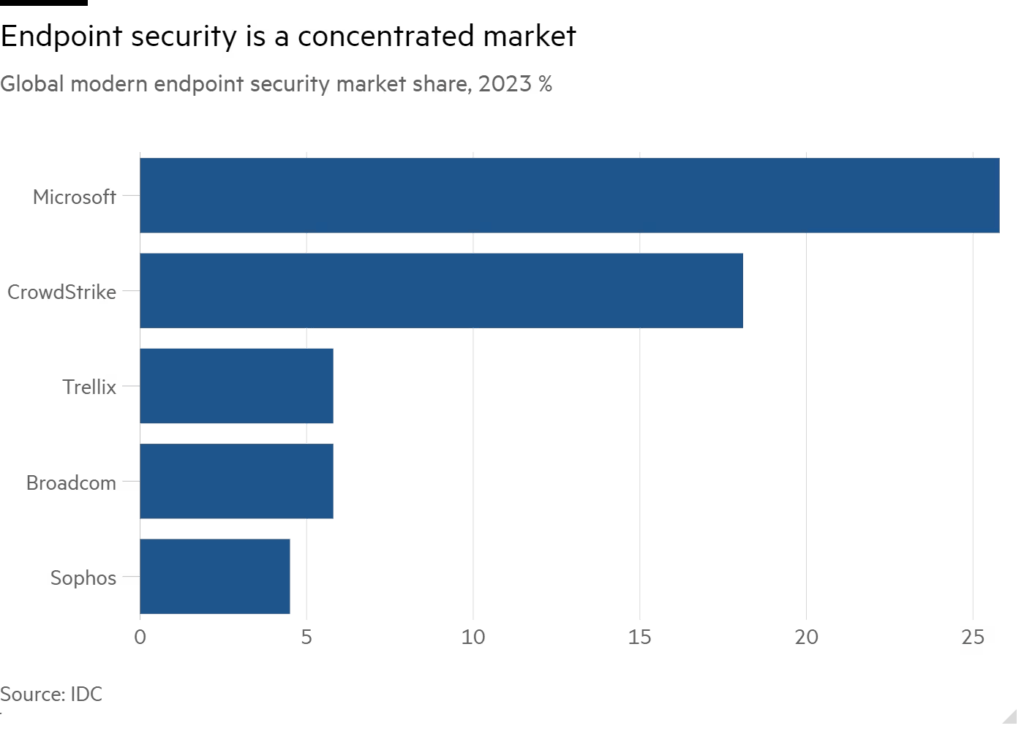In an ironic twist of fate, CrowdStrike, a leading cybersecurity firm tasked with shielding 29,000 clients from digital threats, became the harbinger of one of the most significant disruptions in recent memory. A single, faulty content update to its Falcon Sensor product wreaked havoc on a global scale, rendering businesses across continents powerless. As blue screens of death proliferated from Asia to the US, the incident underscored a critical flaw in our digital infrastructure: over-reliance on a handful of powerful tech giants without adequate backup systems.
The primary issue lies within the supply chain for cloud computing and, consequently, cybersecurity services, which has rendered numerous companies and organizations susceptible to a single point of failure.
The fallout from this debacle is still unfolding, with airlines, banks, broadcasters, and various other sectors grappling with the manual and complex process of restoring their systems. CrowdStrike’s market value plummeted by 9.5 percent, and the broader implications for similar companies are sobering. This event should be a wake-up call for businesses and governments alike about the dangers of putting all their digital eggs in one basket.
The concentration risk in the cybersecurity industry is staggering. Just fifteen companies control 62 percent of the market, with Microsoft and CrowdStrike dominating endpoint security. This oligopoly poses a significant risk: when one falters, the ripple effects are enormous. The lack of diversity in suppliers and the over-dependence on automated updates create a fragile digital ecosystem where a single misstep can lead to widespread chaos.

The incident has exacerbated concerns about the robustness of our digital infrastructure. The US Cyber Safety Review Board focuses on analyzing large-scale cyber attacks, but no entity is tasked with dissecting technical failures to enhance global tech resilience. This oversight gap leaves us vulnerable to systemic risks, as vividly demonstrated by the CrowdStrike fiasco.
Whether we like it or not, technology rules our daily lives. No matter how stable, effective, or powerful it seems, it’s all just software. We’ve constructed a software-driven world, relying on processes we believe are foolproof—until they fail.
European lawmakers are leading the way in tackling the market dominance of these hyperscalers with their new Data Act. This legislation aims to reduce the cost of switching between cloud providers and enhance interoperability.
Sociologist Susan Leigh Starr argued that we only notice infrastructures when they break down. The current crisis illustrates this point perfectly. Our digital infrastructure is not just about physical hardware but also includes the rules, regulations, and norms that bind it together. The global disruption caused by CrowdStrike’s update shows how interconnected and fragile these systems are.
This dependency on technology, and multinational tech corporations like, Alphabet, Amazon, Microsoft, and CrowdStrike for our digital infrastructure is perilous. There’s a glaring lack of redundancy, making our systems extremely vulnerable to even minor technical glitches. The CrowdStrike incident is a stark reminder that our digital infrastructure, much like a house of cards, can collapse spectacularly with one errant move.

One major political-economic shift over the past decade has fueled this fragility: the assetization of software. Software is no longer a one-time purchase but a recurring service, generating continuous revenue streams for companies. This model gives companies more control over their software but also means that users are at their mercy for updates and maintenance. The CrowdStrike update debacle is a prime example of the risks associated with this shift.
The assetization of software extends beyond cybersecurity. From tractors to automobiles, creative apps to business productivity, software controls increasingly dictate how we use our tools and machines, often locking us into expensive service agreements. This shift has eroded user control and increased our dependency on these digital services and corporations.
Everywhere you look: blue screens of death pic.twitter.com/Jh1fdVflTD
— Morning Brew ☕️ (@MorningBrew) July 19, 2024
The fact that these outages hit CrowdStrike and Microsoft is nearly beside the point. It could have happened to anyone. While it’s understandable to be upset with these vendors and to take precautions against future disruptions, it’s crucial to remember that in our software-driven world, bugs and outages are inevitable. They’re simply part of the game.
If anything, the current global outage should prompt a reevaluation of how we manage and govern our digital infrastructure. Clients, governments, and regulators need to prioritize diversification and redundancy in their systems. Relying on a few dominant players without adequate checks and balances is a recipe for disaster.
The CrowdStrike incident is a stark reminder of the fragility of our digital infrastructure. As we continue to integrate digital services into every aspect of our lives, we must build more resilient systems and establish better governance to mitigate these risks. Our future depends on it.











